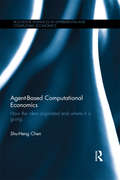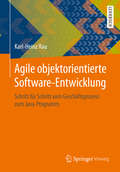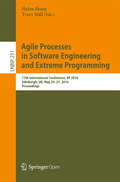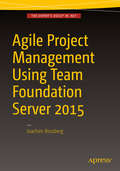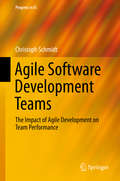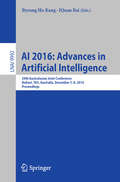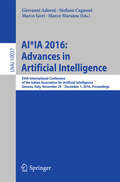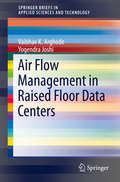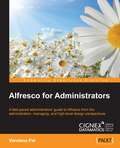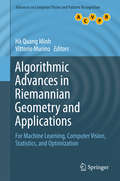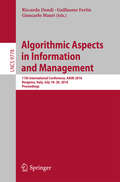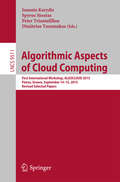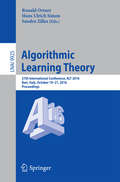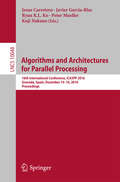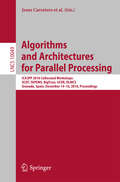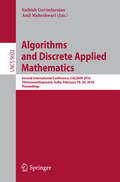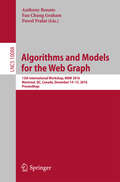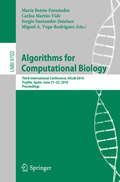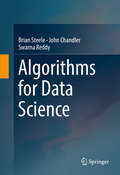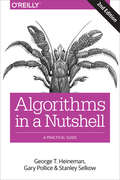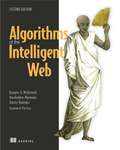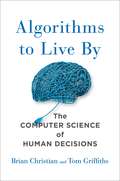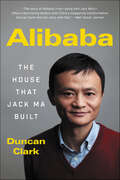- Table View
- List View
Agent-Based Computational Economics: How the idea originated and where it is going (Routledge Advances in Experimental and Computable Economics)
by Shu-Heng ChenThis book aims to answer two questions that are fundamental to the study of agent-based economic models: what is agent-based computational economics and why do we need agent-based economic modelling of economy? This book provides a review of the development of agent-based computational economics (ACE) from a perspective on how artificial economic agents are designed under the influences of complex sciences, experimental economics, artificial intelligence, evolutionary biology, psychology, anthropology and neuroscience. This book begins with a historical review of ACE by tracing its origins. From a modelling viewpoint, ACE brings truly decentralized procedures into market analysis, from a single market to the whole economy. This book also reviews how experimental economics and artificial intelligence have shaped the development of ACE. For the former, the book discusses how ACE models can be used to analyse the economic consequences of cognitive capacity, personality and cultural inheritance. For the latter, the book covers the various tools used to construct artificial adaptive agents, including reinforcement learning, fuzzy decision rules, neural networks, and evolutionary computation. This book will be of interest to graduate students researching computational economics, experimental economics, behavioural economics, and research methodology.
Agile objektorientierte Software-Entwicklung: Schritt für Schritt vom Geschäftsprozess zum Java-Programm
by Karl-Heinz RauDieses Lehrbuch zeigt anhand eines durchgängigen Fallbeispiels wie Anwendungssoftware zur Optimierung von Geschäftsprozessen agil entwickelt werden kann. Auf der Basis eines agilen Vorgehensmodells werden Geschäftsprozesse modelliert, Anwendungsfälle und User Stories abgeleitet sowie in iterativer Weise die Softwarelösung methodisch entworfen und auf der Java EE Plattform beispielhaft implementiert. Dabei kommen Prinzipien und Praktiken agiler Vorgehensweisen zur Anwendung. Nach einer leichtgewichtigen Vorbereitungsphase steht die Entwicklungsphase mit zeitlich festgelegten Iterationen im Mittelpunkt. Die Anforderungen werden als User Stories gut verständlich beschrieben, deren Kontext durch die Anwendungsfälle des Geschäftsprozesses vorgegeben ist. Statische und dynamische UML-Modelle unterstützen die Kommunikation beim Entwurf der User Stories. Die identifizierten System-Operationen werden mit Hilfe von Mustern in systematischer Weise Klassen zugeordnet, Entwurfsmuster werden an Beispielen vorgestellt und praktisch eingesetzt, so dass ein Software-System mit geringer Kopplung und hoher Wartbartkeit entsteht. Das durchgängige Beispiel zeigt dem Leser anschaulich den Weg von der Problemstellung im Geschäftsprozess bis zur Java-Software-Lösung Schritt für Schritt auf. Zu jedem Kapitel werden Wiederholungsfragen und Aufgaben angeboten. Online stehen Quellcode und ergänzende Lernhilfen zur Verfügung.
Agile Processes, in Software Engineering, and Extreme Programming: 17th International Conference, XP 2016, Edinburgh, UK, May 24-27, 2016, Proceedings (Lecture Notes in Business Information Processing #251)
by Helen Sharp Tracy HallThis book contains the refereed proceedings of the 17th International Conference on Agile Software Development, XP 2016, held in Edinburgh, UK, in May 2016. While agile development has already become mainstream in industry, this field is still constantly evolving and continues to spur an enormous interest both in industry and academia. To this end, the XP conference attracts a large number of software practitioners and researchers, providing a rare opportunity for interaction between the two communities. The 14 full papers accepted for XP 2016 were selected from 42 submissions. Additionally, 11 experience reports (from 25 submissions) 5 empirical studies (out of 12 submitted) and 5 doctoral papers (from 6 papers submitted) were selected, and in each case the authors were shepherded by an experienced researcher. Generally, all of the submitted papers went through a rigorous peer-review process.
Agile Project Management using Team Foundation Server 2015
by Joachim RossbergThis book will help you get started with agile project management using Microsoft's latest releases of its market-leading Team Foundation Server (TFS) 2015, and Visual Studio Team Services (VSTS). The book demonstrates agile concepts and how to implement them using TFS/VSTS. Many organizations are using agile practices today. Agility has become a key enabler for running better projects with more successful end results and high quality output. At the same time, adoption of TFS/VSTS has increased dramatically, from being just a new version control system in the very beginning to becoming the fully-featured market leader it is today. In order to benefit the most from agile practices you need an Application Lifecycle Management (ALM) toolset that supports your way of working. With TFS/VSTS, Microsoft has provided a powerful tool that is very customizable. This book shows you how you can use TFS/VSTS to implement many agile practices and how they fit into a well-thought-out ALM implementation. The book also shows how an agile product owner can work with TFS/VSTS to setup an agile project from scratch and how to continue using TFS/VSTS throughout the whole project to track progress, create and refine the backlog, and work with Kanban and Scrum Task boards. Keeping track of progress is important in any project. TFS/VSO includes many tools which will help you to track key metrics in an agile project. Many useful reports are available out of the box, and the TFS extensibility offers several ways to further customize reporting to fit your needs. What you'll learn Agile Concepts and Processes How TFS/VSO supports agile processes end to end How you can customize TFS/VSO to better support your processes How to set up an agile project from scratch and manage it over its lifecycle Who this book is for Software Engineers, Software Product Owners, Project Managers, Scrum Masters,
Agile Software Development Teams: The Impact Of Agile Development On Team Performance (Progress in IS #0)
by Christoph SchmidtThis book explores how agile development practices, in particular pair programming, code review and automated testing, help software development teams to perform better. Agile software engineering has become the standard software development paradigm over the last decade, and the insights provided here are taken from a large-scale survey of 80 professional software development teams working at SAP SE in Germany. In addition, the book introduces a novel measurement tool for assessing the performance of software development teams. No previous study has researched this topic with a similar data set comprising insights from more than 450 professional software engineers.
AI 2016: 29th Australasian Joint Conference, Hobart, TAS, Australia, December 5-8, 2016, Proceedings (Lecture Notes in Computer Science #9992)
by Byeong Ho Kang Quan BaiThis book constitutes the refereed proceedings of the 29th Australasian Joint Conference on Artificial Intelligence, AI 2016, held in Hobart, TAS, Australia, in December 2016. The 40 full papers and 18 short papers presented together with 8 invited short papers were carefully reviewed and selected from 121 submissions. The papers are organized in topical sections on agents and multiagent systems; AI applications and innovations; big data; constraint satisfaction, search and optimisation; knowledge representation and reasoning; machine learning and data mining; social intelligence; and text mining and NLP. The proceedings also contains 2 contributions of the AI 2016 doctoral consortium and 6 contributions of the SMA 2016.
AI*IA 2016 Advances in Artificial Intelligence: XVth International Conference of the Italian Association for Artificial Intelligence, Genova, Italy, November 29 – December 1, 2016, Proceedings (Lecture Notes in Computer Science #10037)
by Giovanni Adorni, Stefano Cagnoni, Marco Gori and Marco MarateaThis book constitutes the refereed proceedings of the 15th International Conference of the Italian Association for Artificial Intelligence, AI*IA 2016, held in Genova, Italy, in November/December 2016. The 39 full papers presented were carefully reviewed and selected from 53 submissions. The papers are organized in topical sections on optimization and evolutionary algorithms; classification, pattern recognition, and computer vision; multi-agent systems; machine learning; semantic web and description logics; natural language processing; planning and scheduling; and formal verification.
Air Flow Management in Raised Floor Data Centers (SpringerBriefs in Applied Sciences and Technology)
by Yogendra Joshi Vaibhav K. ArghodeThe Brief discuss primarily two aspects of air flow management in raised floor data centers. Firstly, cooling air delivery through perforated tiles will be examined and influence of the tile geometry on flow field development and hot air entrainment above perforated tiles will be discussed. Secondly, the use of cold aisle containment to physically separate hot and cold regions, and minimize hot and cold air mixing will be presented. Both experimental investigations and computational efforts are discussed and development of computational fluid dynamics (CFD) based models for simulating air flow in data centers is included. In addition, metrology tools for facility scale air velocity and temperature measurement, and air flow rate measurement through perforated floor tiles and server racks are examined and the authors present thermodynamics-based models to gauge the effectiveness and importance of air flow management schemes in data centers.
Airline e-Commerce: Log on. Take off.
by Michael HankeFrom the few tickets that were sold by Alaska Airlines and former British Midland in December 1995 via the industry’s first airline booking engine websites, global online travel has grown to generate today more than half a trillion dollars in annual revenue. This development has brought significant changes to the airline business, travel markets, and consumers. Today, airlines worldwide not only use e-commerce for online marketing and selling but also as a platform to offer unique services and capabilities that have no counterpart in the physical world. This book is an in-depth introduction to airline e-commerce. It covers a broad scope of areas that are essential to an airline’s ongoing digital transformation. Digital properties & features E-marketing E-sales & distribution Web customer service E-commerce organization E-commerce strategy Written by an airline e-commerce expert and illustrated with numerous examples of leading airlines in this area, Dr. Hanke provides for comprehensive "behind-the-scenes" details of how airline e-commerce works. This book is a crucial companion for students and practitioners alike because it allows the reader to acquire a thorough foundation of airline e-commerce. Furthermore, the book enables the reader to appreciate the ramifications of airline e-commerce in certain corporate areas and to take effective action for a successful e-commerce strategy.
Alfresco for Administrators
by Vandana PalA fast-paced administrator's guide to Alfresco from the administration, managing, and high-level design perspectives About This Book * Understand system capabilities in order to make informed and appropriate decisions about its administration * Manage users, groups, email, file systems, and transformer availability using Alfresco * Use Alfresco to capture and efficiently manage information about repositories, servers, and statistics Who This Book Is For The target audience would be users with a basic knowledge of Content Management System, and also users who want to understand Alfresco from the administration and high-level design perspectives. What You Will Learn * Understand Alfresco's architecture and important building blocks * Learn to install Alfresco on various application servers such as Tomcat , JBoss, and WebLogic. * Become familiar with various configurations in Alfresco such as databases, filesystems, email, and audits * Administrate Alfresco using the Explorer Admin Console, Share Admin Console, and Workflow Admin Console * Understand how to integrate LDAP and Active Directory with Alfresco for centralized user management * Learn how Alfresco environments can be clustered for high availability * Fully understand how Alfresco stores content and easily retrieve any information from Alfresco * Monitor and manage Alfresco systems in production In Detail Alfresco is an open source Enterprise Content Management (ECM) system for Windows and Linux-like operating systems. The year-on-year growth of business connections, contacts, and communications is expanding enterprise boundaries more than ever before. Alfresco enables organizations to collaborate more effectively, improve business process efficiency, and ensure information governance. The basic purpose of Alfresco is to help users to capture and manage information in a better way. It helps you capture, organize, and share binary files. This book will cover the basic building blocks of an Alfresco system, how the components fit together, and the information required to build a system architecture. This book will also focus on security aspects of Alfresco. such as authentication, troubleshooting, managing permissions, and so on. It will also focus on managing content and storage, indexing and searches, setting up clustering for high availability, and so forth. Style and approach A step-by-step guide to understanding the Alfresco system and making informed and appropriate decisions about administration.
Algorithmic Advances in Riemannian Geometry and Applications: For Machine Learning, Computer Vision, Statistics, and Optimization (Advances in Computer Vision and Pattern Recognition)
by Hà Quang Minh Vittorio MurinoThis book presents a selection of the most recent algorithmic advances in Riemannian geometry in the context of machine learning, statistics, optimization, computer vision, and related fields. The unifying theme of the different chapters in the book is the exploitation of the geometry of data using the mathematical machinery of Riemannian geometry. As demonstrated by all the chapters in the book, when the data is intrinsically non-Euclidean, the utilization of this geometrical information can lead to better algorithms that can capture more accurately the structures inherent in the data, leading ultimately to better empirical performance. This book is not intended to be an encyclopedic compilation of the applications of Riemannian geometry. Instead, it focuses on several important research directions that are currently actively pursued by researchers in the field. These include statistical modeling and analysis on manifolds,optimization on manifolds, Riemannian manifolds and kernel methods, and dictionary learning and sparse coding on manifolds. Examples of applications include novel algorithms for Monte Carlo sampling and Gaussian Mixture Model fitting, 3D brain image analysis,image classification, action recognition, and motion tracking.
Algorithmic Aspects in Information and Management: 11th International Conference, AAIM 2016, Bergamo, Italy, July 18-20, 2016, Proceedings (Lecture Notes in Computer Science #9778)
by Riccardo Dondi Guillaume Fertin Giancarlo MauriThis volume constitutes the proceedings of the 11th International Conference on Algorithmic Aspects in Information and Management, AAIM 2016, held in Bergamo, Italy, in July 2016. The 18 revised full papers presented were carefully reviewed and selected from 41 submissions. The papers deal with current trends of research on algorithms, data structures, operation research, combinatorial optimization and their applications.
Algorithmic Aspects of Cloud Computing: First International Workshop, ALGOCLOUD 2015, Patras, Greece, September 14-15, 2015. Revised Selected Papers (Lecture Notes in Computer Science #9511)
by Peter Triantafillou Ioannis Karydis Spyros Sioutas Dimitrios TsoumakosThis book constitutes the thoroughly refereedpost-conference proceedings of the First International Workshop on AlgorithmicAspects of Cloud Computing, ALGOCLOUD 2015, held in Patras, Greece, inSeptember 2015 in conjunction with ALGO 2015. The 13 revised full papers presented together with 2tutorial papers were carefully reviewed and selected from 37 initialsubmissions. They cover a wide range of topics in two main tracks: algorithmicaspects of large-scale data stores, and software tools and distributedarchitectures for cloud-based data management.
Algorithmic Learning Theory: 27th International Conference, ALT 2016, Bari, Italy, October 19-21, 2016, Proceedings (Lecture Notes in Computer Science #9925)
by Ronald Ortner, Hans Ulrich Simon and Sandra ZillesThis book constitutes the refereed proceedings of the 27th International Conference on Algorithmic Learning Theory, ALT 2016, held in Bari, Italy, in October 2016, co-located with the 19th International Conference on Discovery Science, DS 2016. The 24 regular papers presented in this volume were carefully reviewed and selected from 45 submissions. In addition the book contains 5 abstracts of invited talks. The papers are organized in topical sections named: error bounds, sample compression schemes; statistical learning, theory, evolvability; exact and interactive learning; complexity of teaching models; inductive inference; online learning; bandits and reinforcement learning; and clustering.
Algorithms and Architectures for Parallel Processing: 16th International Conference, ICA3PP 2016, Granada, Spain, December 14-16, 2016, Proceedings (Lecture Notes in Computer Science #10048)
by Peter Mueller Jesus Carretero Javier Garcia-Blas Ryan K.L. Ko Koji NakanoThis book constitutes the refereed proceedings of the 16th International Conference on Algorithms and Architectures for Parallel Processing, ICA3PP 2016, held in Granada, Spain, in December 2016. The 30 full papers and 22 short papers presented were carefully reviewed and selected from 117 submissions. They cover many dimensions of parallel algorithms and architectures, encompassing fundamental theoretical approaches, practical experimental projects, and commercial components and systems trying to push beyond the limits of existing technologies, including experimental efforts, innovative systems, and investigations that identify weaknesses in existing parallel processing technology.
Algorithms and Architectures for Parallel Processing: ICA3PP 2016 Collocated Workshops: SCDT, TAPEMS, BigTrust, UCER, DLMCS, Granada, Spain, December 14-16, 2016, Proceedings (Lecture Notes in Computer Science #10049)
by José Gracia Josef Weidendorfer Jesus Carretero Javier Garcia-Blas Victor Gergel Vladimir Voevodin Iosif Meyerov Juan A. Rico-Gallego Juan C. Díaz-Martín Pedro Alonso Juan Durillo José Daniel Garcia Sánchez Alexey L. Lastovetsky Fabrizio Marozzo Qin Liu Zakirul Alam Bhuiyan Karl FürlingerThis book constitutes the refereed workshop proceedings of the 16th International Conference on Algorithms and Architectures for Parallel Processing, ICA3PP 2016, held in Granada, Spain, in December 2016. The 30 full papers presented were carefully reviewed and selected from 58 submissions. They cover many dimensions of parallel algorithms and architectures, encompassing fundamental theoretical approaches, practical experimental projects, and commercial components and systems trying to push beyond the limits of existing technologies, including experimental efforts, innovative systems, and investigations that identify weaknesses in existing parallel processing technology.
Algorithms and Discrete Applied Mathematics: Second International Conference, CALDAM 2016, Thiruvananthapuram, India, February 18-20, 2016, Proceedings (Lecture Notes in Computer Science #9602)
by Sathish Govindarajan Anil MaheshwariThis book collects the refereed proceedingsof the Second International Conference on Algorithms and Discrete AppliedMathematics, CALDAM 2016, held in Thiruvananthapuram, India, in February 2016. The volume contains 30 full revised papers from 90 submissions along with 1invited talk presented at the conference. The conference focuses on topicsrelated to efficient algorithms and data structures, their analysis (boththeoretical and experimental) and the mathematical problems arising thereof,and new applications of discrete mathematics, advances in existing applicationsand development of new tools for discrete mathematics.
Algorithms and Models for Network Data and Link Analysis
by François Fouss Marco Saerens Masashi ShimboNetwork data are produced automatically by everyday interactions - social networks, power grids, and links between data sets are a few examples. Such data capture social and economic behavior in a form that can be analyzed using powerful computational tools. This book is a guide to both basic and advanced techniques and algorithms for extracting useful information from network data. The content is organized around 'tasks', grouping the algorithms needed to gather specific types of information and thus answer specific types of questions. Examples include similarity between nodes in a network, prestige or centrality of individual nodes, and dense regions or communities in a network. Algorithms are derived in detail and summarized in pseudo-code. The book is intended primarily for computer scientists, engineers, statisticians and physicists, but it is also accessible to network scientists based in the social sciences. Matlab/Octave code illustrating some of the algorithms will be available at: http://www. cambridge. org/9781107125773.
Algorithms and Models for the Web Graph: 13th International Workshop, WAW 2016, Montreal, QC, Canada, December 14–15, 2016, Proceedings (Lecture Notes in Computer Science #10088)
by Anthony Bonato Fan Chung Graham Paweł PrałatThis book constitutes the proceedings of the 13th International Workshop on Algorithms and Models for the Web Graph, WAW 2016, held in Montreal, QC, Canada, in December 2016. The workshop gathered the researchers who are working on graph- theoretic and algorithmic aspects of related complex networks, including social networks, citation networks, biological networks, molecular networks, and other networks arising from the Internet.
Algorithms for Computational Biology: Third International Conference, AlCoB 2016, Trujillo, Spain, June 21-22, 2016, Proceedings (Lecture Notes in Computer Science #9702)
by María Botón-Fernández Carlos Martín-Vide Sergio Santander-Jiménez Miguel A. Vega-RodríguezThis book constitutes the proceedings of the Third InternationalConference on Algorithms for Computational Biology, AlCoB 2016, held inTrujillo, Spain, in June 2016.The 13 full papers presented in this volume were carefully reviewed andselected from 23 submissions. They are organized in the following topical sections: biological networks and modelling; biological structure processing; phylogenetics; and sequence analysis and rearrangement. In addition one invited talk is included.
Algorithms for Data Science
by John Chandler Brian Steele Swarna ReddyThis textbook on practical data analytics unites fundamental principles, algorithms, and data. Algorithms are the keystone of data analytics and the focal point of this textbook. Clear and intuitive explanations of the mathematical and statistical foundations make the algorithms transparent. But practical data analytics requires more than just the foundations. Problems and data are enormously variable and only the most elementary of algorithms can be used without modification. Programming fluency and experience with real and challenging data is indispensable and so the reader is immersed in Python and R and real data analysis. By the end of the book, the reader will have gained the ability to adapt algorithms to new problems and carry out innovative analyses. This book has three parts: (a) Data Reduction: Begins with the concepts of data reduction, data maps, and information extraction. The second chapter introduces associative statistics, the mathematical foundation of scalable algorithms and distributed computing. Practical aspects of distributed computing is the subject of the Hadoop and MapReduce chapter. (b) Extracting Information from Data: Linear regression and data visualization are the principal topics of Part II. The authors dedicate a chapter to the critical domain of Healthcare Analytics for an extended example of practical data analytics. The algorithms and analytics will be of much interest to practitioners interested in utilizing the large and unwieldly data sets of the Centers for Disease Control and Prevention's Behavioral Risk Factor Surveillance System. (c) Predictive Analytics Two foundational and widely used algorithms, k-nearest neighbors and naive Bayes, are developed in detail. A chapter is dedicated to forecasting. The last chapter focuses on streaming data and uses publicly accessible data streams originating from the Twitter API and the NASDAQ stock market in the tutorials. This book is intended for a one- or two-semester course in data analytics for upper-division undergraduate and graduate students in mathematics, statistics, and computer science. The prerequisites are kept low, and students with one or two courses in probability or statistics, an exposure to vectors and matrices, and a programming course will have no difficulty. The core material of every chapter is accessible to all with these prerequisites. The chapters often expand at the close with innovations of interest to practitioners of data science. Each chapter includes exercises of varying levels of difficulty. The text is eminently suitable for self-study and an exceptional resource for practitioners.
Algorithms in a Nutshell: A Practical Guide
by Gary Pollice George T. Heineman Stanley SelkowCreating robust software requires the use of efficient algorithms, but programmers seldom think about them until a problem occurs. This updated edition of Algorithms in a Nutshell describes a large number of existing algorithms for solving a variety of problems, and helps you select and implement the right algorithm for your needs--with just enough math to let you understand and analyze algorithm performance.With its focus on application, rather than theory, this book provides efficient code solutions in several programming languages that you can easily adapt to a specific project. Each major algorithm is presented in the style of a design pattern that includes information to help you understand why and when the algorithm is appropriate.With this book, you will:Solve a particular coding problem or improve on the performance of an existing solutionQuickly locate algorithms that relate to the problems you want to solve, and determine why a particular algorithm is the right one to useGet algorithmic solutions in C, C++, Java, and Ruby with implementation tipsLearn the expected performance of an algorithm, and the conditions it needs to perform at its bestDiscover the impact that similar design decisions have on different algorithmsLearn advanced data structures to improve the efficiency of algorithms
Algorithms of the Intelligent Web
by Doug McIlwraithSummaryAlgorithms of the Intelligent Web, Second Edition teaches the most important approaches to algorithmic web data analysis, enabling you to create your own machine learning applications that crunch, munge, and wrangle data collected from users, web applications, sensors and website logs.Purchase of the print book includes a free eBook in PDF, Kindle, and ePub formats from Manning Publications.About the TechnologyValuable insights are buried in the tracks web users leave as they navigate pages and applications. You can uncover them by using intelligent algorithms like the ones that have earned Facebook, Google, and Twitter a place among the giants of web data pattern extraction.About the BookAlgorithms of the Intelligent Web, Second Edition teaches you how to create machine learning applications that crunch and wrangle data collected from users, web applications, and website logs. In this totally revised edition, you'll look at intelligent algorithms that extract real value from data. Key machine learning concepts are explained with code examples in Python's scikit-learn. This book guides you through algorithms to capture, store, and structure data streams coming from the web. You'll explore recommendation engines and dive into classification via statistical algorithms, neural networks, and deep learning.What's InsideIntroduction to machine learningExtracting structure from dataDeep learning and neural networksHow recommendation engines workAbout the ReaderKnowledge of Python is assumed.About the AuthorsDouglas McIlwraith is a machine learning expert and data science practitioner in the field of online advertising. Dr. Haralambos Marmanis is a pioneer in the adoption of machine learning techniques for industrial solutions. Dmitry Babenko designs applications for banking, insurance, and supply-chain management. Foreword by Yike Guo.Table of ContentsBuilding applications for the intelligent webExtracting structure from data: clustering and transforming your data Recommending relevant contentClassification: placing things where they belongCase study: click prediction for online advertisingDeep learning and neural networksMaking the right choiceThe future of the intelligent webAppendix - Capturing data on the web
Algorithms To Live By: What Computers Can Teach Us About Solving Human Problems
by Brian Christian Tom GriffithsA fascinating exploration of how insights from computer algorithms can be applied to our everyday lives, helping to solve common decision-making problems and illuminate the workings of the human mind All our lives are constrained by limited space and time, limits that give rise to a particular set of problems. What should we do, or leave undone, in a day or a lifetime? How much messiness should we accept? What balance of new activities and familiar favorites is the most fulfilling? These may seem like uniquely human quandaries, but they are not: computers, too, face the same constraints, so computer scientists have been grappling with their version of such issues for decades. And the solutions they've found have much to teach us. In a dazzlingly interdisciplinary work, acclaimed author Brian Christian and cognitive scientist Tom Griffiths show how the algorithms used by computers can also untangle very human questions. They explain how to have better hunches and when to leave things to chance, how to deal with overwhelming choices and how best to connect with others. From finding a spouse to finding a parking spot, from organizing one's inbox to understanding the workings of memory, Algorithms to Live By transforms the wisdom of computer science into strategies for human living.
Alibaba: The House That Jack Ma Built
by Duncan ClarkIn just a decade and half Jack Ma, a man who rose from humble beginnings and started his career as an English teacher, founded and built Alibaba into the second largest Internet company in the world. The company’s $25 billion IPO in 2014 was the world’s largest, valuing the company more than Facebook or Coca Cola. Alibaba today runs the e-commerce services that hundreds of millions of Chinese consumers depend on every day, providing employment and income for tens of millions more. A Rockefeller of his age, Jack has become an icon for the country’s booming private sector, and as the face of the new, consumerist China is courted by heads of state and CEOs from around the world.Granted unprecedented access to a wealth of new material including exclusive interviews, Clark draws on his own first-hand experience of key figures integral to Alibaba’s rise to create an authoritative, compelling narrative account of how Alibaba and its charismatic creator have transformed the way that Chinese exercise their new found economic freedom, inspiring entrepreneurs around the world and infuriating others, turning the tables on the Silicon Valley giants who have tried to stand in his way. Duncan explores vital questions about the company’s past, present, and future: How, from such unremarkable origins, did Jack Ma build Alibaba? What explains his relentless drive and his ability to outsmart his competitors? With over 80% of China’s e-commerce market, how long can the company hope to maintain its dominance? As the company sets its sights on the country’s financial and media markets, are there limits to Alibaba’s ambitions, or will the Chinese government act to curtail them? And as it set up shop from LA and San Francisco to Seattle, how will Alibaba grow its presence and investments in the US and other international markets?Clark tells Alibaba’s tale within the wider story of China’s economic explosion—the rise of the private sector and the expansion of Internet usage—that haver powered the country’s rise to become the world’s second largest economy and largest Internet population, twice the size of the United States. He also explores the political and social context for these momentous changes. An expert insider with unrivaled connections, Clark has a deep understanding of Chinese business mindset. He illuminates an unlikely corporate titan as never before, and examines the key role his company has played in transforming China while increasing its power and presence worldwide.
